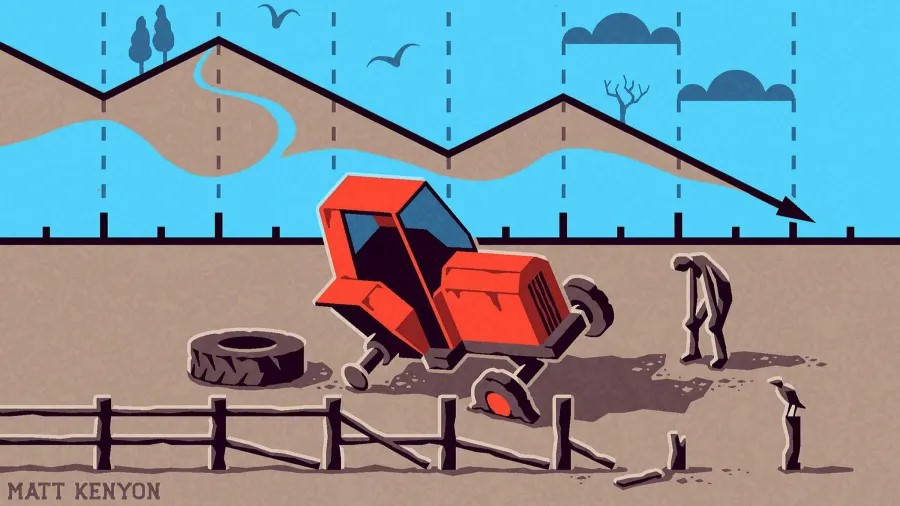BY: Rana Foroohar

PEJOURNAL – Of all the many problems caused by Covid-19, three of the most visible have been food insecurity, the demise of small businesses and asset market volatility.
All of those things might be poised to get worse, thanks to an unexpected but important financial shift. Big banks, including ABN Amro, ING and BNP Paribas, are either pulling out of commodity trade financing or scaling it back. This will leave a funding hole for some farmers, agricultural producers and distributors, as well as grocery chains and other small and medium-sized companies that represent crucial parts of the global food supply chain.
The problem is like a gigantic iceberg under the surface of financial markets, one that we can’t yet see but are nonetheless headed for, according to Michael Greenberger, a professor at the University of Maryland’s Carey School of Law and former director of trading and markets at the US Commodity Futures Trading Commission. He is worried that if second and third-tier agricultural companies — who depend on such financing for things like shipping or manufacturing but also to hedge prices in a volatile industry — cannot get funding or are forced to pay higher rates to shadow lenders, we could see a food price surge.
We might also see greater corporate concentration and increased market risk, he notes, possibly within the next couple of months. “Every commercial producer has to hedge risk by buying futures contracts,” says Prof Greenberger, who points out that growing cycles take months, during which time prices can fluctuate wildly. In order to do that, they may need short-term trade financing. If banks are willing to lend only to the largest and most established players, for example the big global commodities traders such as Vitol Group, Trafigura and Mercuria, or American agricultural giants including Cargill, ADM or Bunge, then small and midsized producers will be forced to go to shadow banks, a practice that is already common.
That, along with the lack of transparency that comes with having no single clearinghouse for such deals, makes it nearly impossible for lenders to tell if, for example, a borrower may have pledged the same collateral more than once. Already, there are signs of the looming risks. Last spring, a series of commodity trading scandals in Singapore — including the blow-up of Hin Leong Trading after its founder hid $800m in losses — highlighted not only garden variety fraud, but the fact that opacity, leverage and volatility in the commodities sector make it a particularly risky area for large banks to do business.
Given the pressure that banks are already under, with higher capital requirements from international regulations compounded by new funding pressures from the pandemic, it’s no wonder that many of them have simply decided to pull out, or just do business with the largest brand name clients that have the biggest balance sheets. This exacerbates an existing trend that is gaining steam post-Covid-19: the biggest companies are getting even bigger. This was true in agriculture, as in so many sectors, long before the pandemic hit. But Covid-19 has starkly exposed the vulnerabilities of monopoly power in food, creating supply gluts in some areas and shortages and higher prices in others.
A handful of large companies have controlled areas such as meat packing and grain production, often doing business with only one type of distributor — a restaurant, for example, but not a grocery store. The result was certainly an economically “efficient” system, but one that turned out to be quite fragile as well. Prof Greenberger and some other experts believe that the shifts of big banks away from trade finance could expose more such fragility. “The first order of worry is being able to get a futures contract — will small producers have to pay a lot more for one? Then, if the contract goes against you, can you make your margin payment?”
If some of them can’t, it is easy to imagine another disruption in supply chains creating more chaos and food insecurity later this year. That could possibly provoke market volatility if enough highly leveraged agricultural companies went out of business at once. Not only would the demise of smaller farmers have a knock-on effect on other businesses, including packaging, manufacturing and transport, but their debt — particularly if packaged into risky securitised products — could become a broader market risk. At the very least, given higher lending costs for a large chunk of producers, higher food prices would seem a foregone conclusion. That won’t be happy news for the legions of unemployed consumers struggling to make ends meet.
This underscores a key point — the ramifications of commodity price disruptions are very often not just economic. They become political, too. Social unrest and even revolutions often start when the prices of food and fuel spike. Bread riots were one of the catalysts for the Arab uprising of 2011. In the US, the oil price spike that began the same year led to senate hearings about whether the problems of the 2008 financial crisis, including risky trading on the part of big banks, had yet been solved. Big banks have thrived despite the restrictions put on them over the past decade. Big Agriculture and commodities traders will probably do the same now. Others may not be so lucky.